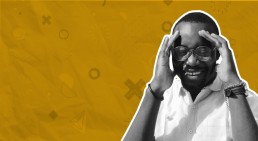
Have you ever been in a situation where a project scheduled to run for say one month, is already past the 6-month mark with no end in sight? Well, I have and as exasperating as these situations usually are, you know what they say about a problem shared right? So, let’s talk about this.
Unending projects could be as a result of several reasons, either owing to the client’s indecisiveness or changing project specifications, you name it.
But first, here’s what birthed the idea for this conversation. I recently attended the Abuja Interaction Design Foundation (IDF) UX meet-up, a remarkable UX designers community hangout hosted by Gordon Timehin, a key driver who serves actively in the Nigerian UX community.
Founded in Denmark in 2002, IDF is a global non-profit initiative and the world’s leading online community for UX design learning. They create accessible and affordable Ivy-League level design education. Essentially, they are driven to facilitate low-cost, high-quality global design education. And in over a decade, they have built and grown a sustainable collaboration and education platform and grown a global community that has reached over 454 local groups in 90 countries. You can check out what they are up to (https://www.interaction-design.org/community).
At the event last week, varied conversations ensued but when this common question of shifting project timelines came up, It occurred to me that this conversation would prove invaluable for not just creative designers but entrepreneurs, businesses or anyone who manages or spearheads projects in the course of their lives work.
Let’s take a look at the insights shared by the really talented members of the UX community, these insights can also apply to any professional irrespective of industry.
The Client Is NOT The Enemy
Most creatives or designers see clients as people to be dreaded or endured until the project is done and they get paid. One way to explain this could be the communication gap between the client and the design professional or entrepreneur who is tasked with articulating the client’s needs while at the same time balancing it with his/her creative and technical know-how.
To overcome the challenge of unending projects, it is important to first understand that the client is NOT the enemy. You may ask, how does this help?
Here’s what adopting this perspective does ; you are inclined to understand the client and his/her business. You want to understand where they are coming from, who they are as individuals and what they are looking for. Some clients are very imaginative and can easily articulate what they want, others can be influenced by several other dynamics. So, you have to understand who that client is and what makes him or her unique. Once you get this, dealing with the client becomes easier. When you understand the client’s psychological make-up and decision-making predilection, it makes it easier to engage them and transfer ideas to real-time designs or in your case, outlined project outcomes.
Know Thy Client And Their Business.
Secondly, you need to have a working knowledge of the client’s business. If you communicate your understanding of the client’s business and can discuss their business with them on a very relatable level, it builds trust.
It makes the client feel like they can trust your ideas because you have successfully presented a picture of one who understands the in and out of the business and not just the business processes but the internal dynamics of the specific challenges they are facing. For example, the lack or abundance of funds or what approaches they can appropriate to get the best value for resources expended.
Create Clear Project Scope.
Based on this understanding of the client’s business, build a very clear-cut project scope, that encompasses the deliverables, timelines, scale, relevant terms and conditions, payment plan and finances, processes and systems and the factors that affect execution. This should be as agreed upon by both parties.
Questions like, “What do we want to achieve with this project?” should be clearly defined. This should not just be verbally discussed, always create an email thread, proposal or some document, that codifies the agreement and can be used to hold the client accountable.
Projects should have a clear-cut start and end date. In essence, let there be a contract that binds the relationship with expected returns on investment.
Break Down The Project Into Sprints.
Next, break down the project into sprints. These sprints are a measure of micro-deliverables of what we are set to achieve at what point and when payment should be expected.
This is such that when the project is extending past the slated time, there is a form of protection for you the project manager or strategist and at least payments have been made for achieved timelines and no payments are hanging somewhere.
These sprints can be broken down into hours, days, weeks, across preferably three, four instalments over the project timeframe. These instalments further help to cement the client’s trust, in that, one milestone is achieved, it closes, the next one continues, it closes and on and on till the end of the project.
Communicate Implications & Financial Cost For Significant Changes In The Project Plan or Implementation.
Every client wants the best for their project and would like to derive value from you. As such, some clients may introduce changes to the design or project plan as often as they experience light bulb moments.
Thus, you need to make the client understand the implication of every significant change in project design or implementation after the final agreement.
For every requested change in action, there is a reaction. This can either translate to a time cost or even resources. For example, if a client requests an additional design that wasn’t in the original project deliverables, you can inform them of the additional cost or extended delivery time frame.
Additional tips include;
–Reevaluate your goals as the project unravels: Update results, milestones frequently to paint a clear picture of what’s necessary and what’s not relevant in the project scope
–Anticipate the end of the project: Hope is a powerful thing, it fuels and energizes your mindset and keeps you running productively towards the finish line.
–Sometimes, put a stop: This may be difficult, however, it is advisable to politely end client relationships that are unpleasant and unhealthy, within good reason.
In doing so, ensure that there is a smooth transition between you and whoever is taking over the project. A stop in the project should not translate to a stop in your relationship. Also, communicate the reason why you are discontinuing the project.
More importantly, understand that the aforementioned guidelines culled from the UX community meet-up are not a one-size-fits-all and so it’s important that in addition to your understanding of your client, you learn to apply discretion in dealing with them, know when to be flexible and when to be rigid.
Nonetheless, you never err in trying to build a process. For where there is no process, anything goes.
I hope these guidelines prove helpful and ensure more fulfilling projects for you in the future!
Are there other tips you’ve adopted in the past? We’d love to hear in the comment section. Talk to me!

About the Author
Century Favour is an Entrepreneur, Strategy, Technology, Marketing and Creative professional passionate about driving economic & social impact. Through his ventures (Endgame The Strategy Company, Do take action & centuryfavour.com) he works to ensure that People, Businesses, Governments & Non-Profits grow, succeed, achieve their strategic objectives, drive sustainable development and positively shape the future of the people & communities they serve.

About the Author
Century Favour is an Entrepreneur, Strategy, Technology, Marketing and Creative professional passionate about driving economic & social impact. Through his ventures (Endgame The Strategy Company, Do take action & centuryfavour.com) he works to ensure that People, Businesses, Governments & Non-Profits grow, succeed, achieve their strategic objectives, drive sustainable development and positively shape the future of the people & communities they serve.